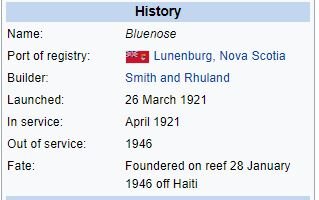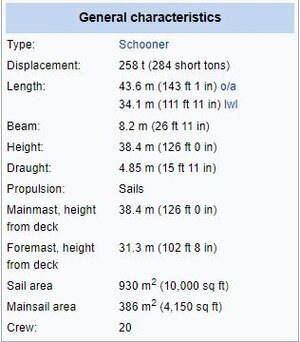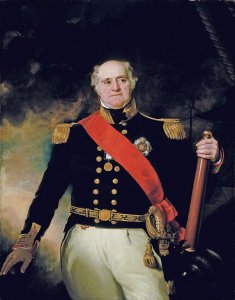Today in Naval History - Naval / Maritime Events in History
26th of March
some of the events you will find here,
please use the following link where you will find more details and all other events of this day .....
1778 – Launch of French Surveillante, an Iphigénie-class 32-gun frigate of the French Navy
Surveillante was an Iphigénie-class 32-gun frigate of the French Navy. She took part in the Naval operations in the American Revolutionary War, where she became famous for her battle with HMS Quebec; in 1783, she brought the news that the war was over to America. She later took part in the French Revolutionary Wars, and was eventually scuttled during the Expédition d'Irlande after sustaining severe damage in a storm. The wreck was found in 1979 and is now a memorial.

Battle between the French frigate Surveillante and the British frigate Quebec, 6 October 1779. Auguste-Louis Rossel de Cercy
1796 – Launch of HMS Clyde and HMS Tamar, both Royal Navy Artois-class frigates, built at Chatham Dockyard of fir (pitch pine)
HMS Clyde was a Royal Navy Artois-class frigate built at Chatham Dockyard of fir (pitch pine), and launched in 1796. In 1797, she was one of only two ships whose captains were able to maintain some control over their vessels during the Nore mutiny. In 1805, HMS Clyde was dismantled and rebuilt at Woolwich Dockyard; she was relaunched on 23 February 1806. She was ultimately sold in August 1814.

HMS 'Clyde' Arriving at Sheerness After the 'Nore' Mutiny, 30 May 1797
1800 - Launch of HMS Courageux, a 74-gun third rate ship of the line of the Royal Navy, at Deptford.
HMS Courageux was a 74-gun third rate ship of the line of the Royal Navy, launched on 26 March 1800 at Deptford. She was designed by Sir John Henslow as one of the large class 74-gun ships, and was the only ship built to her draught. Unlike the middling and common class 74-gun ships, which carried 18-pounder long guns, as a large 74-gun ship, Courageux carried 24-pounders on her upper gun deck.

1806 - HMS Pique (40), Charles Bayne Hodgson Ross, captured Voltigeur (16), Jacques Saint-Cricq, and Phaeton (16), Louis-Henri Freycinet-Saulce, in the West Indies
The French brig Voltigeur was a Palinure-class brig launched in 1804. The British captured her in 1806 and renamed her HMS Pelican. She was sold in 1812.

1808 - french brig Friedland, the name-ship of her class of French Illyrien or Friedland-class, was captured by 64-gun third rate HMS Standard and the 38-gun frigate HMS Active
Friedland was the name-ship of her class of French Illyrien or Friedland-class brig. She was built at Venice and launched in June 1807. The Royal Navy captured her a year later and took her into service as HMS Delight. She served in the Mediterranean and was sold in 1814.

Scale: 1:48. Plan showing the body plan with stern board detail, sheer lines with inboard detail, and longitudinal half-breadth for 'Standard' (1782), a 64-gun Third Rate, two-decker, as built at Deptford Dockyard. Signed by Adam Hayes [Master Shipwright, Deptford Dockyard, 1755-1785 (died)].
1811 – Launch of HMS Havannah, a Royal Navy 36-gun fifth-rate frigate.
HMS Havannah was a Royal Navy 36-gun fifth-rate frigate. She was launched in 1811 and was one of twenty-seven Apollo-class frigates. She was cut down to a 24-gun sixth rate in 1845, converted to a training ship in 1860, and sold for breaking up in 1905.
sistership Euralus

1814 - Battle of Jobourg
HMS Hebrus (36), Cptn. Edmund Palmer, took French Etoile (44), Cptn. Henri Pierre Philibert, and HMS Hannibal (74), Cptn. Sir Michael Seymour, took Sultane (40) in the Channel.
The Battle of Jobourg was a minor naval engagement between British and French frigate squadrons during the last weeks of the War of the Sixth Coalition in the 22nd and penultimate year of the French Revolutionary and Napoleonic Wars. In October 1813 the French Navy, unable to challenge the Royal Navy's dominance at sea, sent two small squadrons of frigates to harass British trade in the Atlantic Ocean. One was brought to battle in January 1814 and defeated near the Canary Islands but the second, from Nantes and consisting of the frigates Etoile and Sultane, fought an inconclusive engagement against British frigate HMS Severn on 4 January in the mid-Atlantic and a furious battle against HMS Astrea and HMS Creole on 23 January near Maio in the Cape Verde Islands.

1822 – Launch of HMS Rattlesnake, an Atholl-class 28-gun sixth-rate corvette of the Royal Navy
HMS Rattlesnake was an Atholl-class 28-gun sixth-rate corvette of the Royal Navy launched in 1822. She made a historic voyage of discovery to the Cape York and Torres Strait areas of northern Australia.

Rattlesnake, painted by Sir Oswald Walters Brierly, 1853
1834 – Launch of French Belle-Poule, a Surveillante-class 60-gun first rank frigate of the French Navy.
She achieved fame for bringing the remains of Napoleon from Saint Helena back to France, in what became known as the Retour des cendres.
Belle-Poule was a Surveillante-class 60-gun first rank frigate of the French Navy. She achieved fame for bringing the remains of Napoleon from Saint Helena back to France, in what became known as the Retour des cendres.

Model of Belle-Poule, on display at Toulon naval museum.
1941 - The Raid on Souda Bay was an assault by Italian Royal Navy small craft on Souda Bay, Crete
The Royal Navy heavy cruiser HMS York and the Norwegian tanker Pericles were disabled by the Italian motor launches and eventually lost.
The Raid on Souda Bay was an assault by Italian Royal Navy small craft on Souda Bay, Crete, during the first hours of 26 March 1941. The Royal Navy heavy cruiser HMS York and the Norwegian tanker Pericles were disabled by the Italian motor launches and eventually lost.

HMS York's hull boarded by the Italian Torpedo Boat Sirio
26th of March
some of the events you will find here,
please use the following link where you will find more details and all other events of this day .....
Naval/Maritime History - 27th of August - Today in Naval History - Naval / Maritime Events in History
Today in Naval History - Naval / Maritime Events in History 25 March 1777 – Launch of HMS Ceres, an 18-gun sloop launched in 1777 for the British Royal Navy that the French captured in December 1778 off Saint Lucia. HMS Ceres was an 18-gun sloop launched in 1777 for the British Royal Navy that...
shipsofscale.com
1778 – Launch of French Surveillante, an Iphigénie-class 32-gun frigate of the French Navy
Surveillante was an Iphigénie-class 32-gun frigate of the French Navy. She took part in the Naval operations in the American Revolutionary War, where she became famous for her battle with HMS Quebec; in 1783, she brought the news that the war was over to America. She later took part in the French Revolutionary Wars, and was eventually scuttled during the Expédition d'Irlande after sustaining severe damage in a storm. The wreck was found in 1979 and is now a memorial.
Battle between the French frigate Surveillante and the British frigate Quebec, 6 October 1779. Auguste-Louis Rossel de Cercy
1796 – Launch of HMS Clyde and HMS Tamar, both Royal Navy Artois-class frigates, built at Chatham Dockyard of fir (pitch pine)
HMS Clyde was a Royal Navy Artois-class frigate built at Chatham Dockyard of fir (pitch pine), and launched in 1796. In 1797, she was one of only two ships whose captains were able to maintain some control over their vessels during the Nore mutiny. In 1805, HMS Clyde was dismantled and rebuilt at Woolwich Dockyard; she was relaunched on 23 February 1806. She was ultimately sold in August 1814.
HMS 'Clyde' Arriving at Sheerness After the 'Nore' Mutiny, 30 May 1797
1800 - Launch of HMS Courageux, a 74-gun third rate ship of the line of the Royal Navy, at Deptford.
HMS Courageux was a 74-gun third rate ship of the line of the Royal Navy, launched on 26 March 1800 at Deptford. She was designed by Sir John Henslow as one of the large class 74-gun ships, and was the only ship built to her draught. Unlike the middling and common class 74-gun ships, which carried 18-pounder long guns, as a large 74-gun ship, Courageux carried 24-pounders on her upper gun deck.
1806 - HMS Pique (40), Charles Bayne Hodgson Ross, captured Voltigeur (16), Jacques Saint-Cricq, and Phaeton (16), Louis-Henri Freycinet-Saulce, in the West Indies
The French brig Voltigeur was a Palinure-class brig launched in 1804. The British captured her in 1806 and renamed her HMS Pelican. She was sold in 1812.
1808 - french brig Friedland, the name-ship of her class of French Illyrien or Friedland-class, was captured by 64-gun third rate HMS Standard and the 38-gun frigate HMS Active
Friedland was the name-ship of her class of French Illyrien or Friedland-class brig. She was built at Venice and launched in June 1807. The Royal Navy captured her a year later and took her into service as HMS Delight. She served in the Mediterranean and was sold in 1814.
Scale: 1:48. Plan showing the body plan with stern board detail, sheer lines with inboard detail, and longitudinal half-breadth for 'Standard' (1782), a 64-gun Third Rate, two-decker, as built at Deptford Dockyard. Signed by Adam Hayes [Master Shipwright, Deptford Dockyard, 1755-1785 (died)].
1811 – Launch of HMS Havannah, a Royal Navy 36-gun fifth-rate frigate.
HMS Havannah was a Royal Navy 36-gun fifth-rate frigate. She was launched in 1811 and was one of twenty-seven Apollo-class frigates. She was cut down to a 24-gun sixth rate in 1845, converted to a training ship in 1860, and sold for breaking up in 1905.
sistership Euralus
1814 - Battle of Jobourg
HMS Hebrus (36), Cptn. Edmund Palmer, took French Etoile (44), Cptn. Henri Pierre Philibert, and HMS Hannibal (74), Cptn. Sir Michael Seymour, took Sultane (40) in the Channel.
The Battle of Jobourg was a minor naval engagement between British and French frigate squadrons during the last weeks of the War of the Sixth Coalition in the 22nd and penultimate year of the French Revolutionary and Napoleonic Wars. In October 1813 the French Navy, unable to challenge the Royal Navy's dominance at sea, sent two small squadrons of frigates to harass British trade in the Atlantic Ocean. One was brought to battle in January 1814 and defeated near the Canary Islands but the second, from Nantes and consisting of the frigates Etoile and Sultane, fought an inconclusive engagement against British frigate HMS Severn on 4 January in the mid-Atlantic and a furious battle against HMS Astrea and HMS Creole on 23 January near Maio in the Cape Verde Islands.
1822 – Launch of HMS Rattlesnake, an Atholl-class 28-gun sixth-rate corvette of the Royal Navy
HMS Rattlesnake was an Atholl-class 28-gun sixth-rate corvette of the Royal Navy launched in 1822. She made a historic voyage of discovery to the Cape York and Torres Strait areas of northern Australia.
Rattlesnake, painted by Sir Oswald Walters Brierly, 1853
1834 – Launch of French Belle-Poule, a Surveillante-class 60-gun first rank frigate of the French Navy.
She achieved fame for bringing the remains of Napoleon from Saint Helena back to France, in what became known as the Retour des cendres.
Belle-Poule was a Surveillante-class 60-gun first rank frigate of the French Navy. She achieved fame for bringing the remains of Napoleon from Saint Helena back to France, in what became known as the Retour des cendres.
Model of Belle-Poule, on display at Toulon naval museum.
1941 - The Raid on Souda Bay was an assault by Italian Royal Navy small craft on Souda Bay, Crete
The Royal Navy heavy cruiser HMS York and the Norwegian tanker Pericles were disabled by the Italian motor launches and eventually lost.
The Raid on Souda Bay was an assault by Italian Royal Navy small craft on Souda Bay, Crete, during the first hours of 26 March 1941. The Royal Navy heavy cruiser HMS York and the Norwegian tanker Pericles were disabled by the Italian motor launches and eventually lost.
HMS York's hull boarded by the Italian Torpedo Boat Sirio











